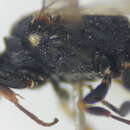fr
noms dans le fil d’Ariane


Pemphredoninae ist eine Unterfamilie der Crabronidae innerhalb der Grabwespen (Spheciformes). Sie umfasst nach Pulawski (2009) 37 Gattungen in vier Triben.[1] In Europa ist die Unterfamilie mit 107 Arten in 13 Gattungen vertreten.[2]
Die kleinen bis mittelgroßen Grabwespen sind häufig schwarz gefärbt. Manche Arten besitzen eine rot gefärbte Hinterleibsbasis, einige zeigen gelbe Färbungen. Bei vielen Arten ist das erste Sternit des Hinterleibs stielartig ausgebildet. Die Schienen (Tibien) der mittleren Beinpaare tragen nur einen Sporn. Die Arten, die keine stielartige Hinterleibsbasis haben, haben in den Vorderflügeln nur zwei Submarginalzellen und häufig ein deutlich vergrößertes Flügelmal.[3]
Die Pemphredoninae zählen zu den am weitesten entwickelten Grabwespen und haben teilweise bereits bienenähnliches Verhalten. So sind die Arten der Gattung Microstigmus die einzigen eusozial lebenden Grabwespen. Bei manchen Arten kleiden die Weibchen ihre Nester mit einem seidenartigen Gewebe aus. Auch werden bei manchen Arten mehrere wehrlose Futtertiere gesammelt und in das Nest eingebracht, anstatt ein Beutetier gejagt. Das Ei wird dann inmitten dieses Vorrats abgelegt. Bei manchen Arten vollführen die Männchen vor der Paarung ein kompliziertes Balzritual.[3]
Im Folgenden werden alle derzeit anerkannten rezenten Subtaxa[1] bis hinunter zur Gattung sowie die europäischen Arten aufgelistet:
Pemphredoninae ist eine Unterfamilie der Crabronidae innerhalb der Grabwespen (Spheciformes). Sie umfasst nach Pulawski (2009) 37 Gattungen in vier Triben. In Europa ist die Unterfamilie mit 107 Arten in 13 Gattungen vertreten.
The subfamily Pemphredoninae also known as the aphid wasps,[1] is a large group in the wasp family Crabronidae, with over 1000 species. Historically, this subfamily has frequently been accorded family status. In some recent phylogenetic analyses, one of the subtribes within this group is the sister lineage to the superfamily Apoidea, and accorded family rank as Ammoplanidae along with Pemphredonidae and Psenidae so as to keep families monophyletic.[2]
The subfamily consists of solitary wasps, each genus having its own distinct and consistent prey preferences. The adult females dig tunnels in the ground, or plant material, for nesting.[3]
As with all other sphecoid wasps, the larvae are carnivorous; females hunt for prey on which to lay their eggs, mass provisioning the nest cells with paralyzed, living prey that the larvae feed upon after hatching from the egg.
In most classifications, the Pemphredoninae are divided into four tribes: Entomosericini, Odontosphecini, Psenini, and Pemphredonini; the last of which has by far the largest number of species. The primary distinction between the Psenini and the Pemphredonini is that Psenini have a forewing with three submarginal cells, while Pemphredonini never have more than two submarginal cells in their forewing. More recent classifications treat Psenidae (including Odontosphecini) as a separate family, and sister to the newly-erected family Ammoplanidae, while Pemphredonidae (excluding Ammoplanina) is sister taxon to the Philanthidae.[2]
Two fossilized wasps from the Weald Clay, Archisphex and Angarosphex are considered to possibly be in the Pemphredoninae.[4]
The subfamily Pemphredoninae also known as the aphid wasps, is a large group in the wasp family Crabronidae, with over 1000 species. Historically, this subfamily has frequently been accorded family status. In some recent phylogenetic analyses, one of the subtribes within this group is the sister lineage to the superfamily Apoidea, and accorded family rank as Ammoplanidae along with Pemphredonidae and Psenidae so as to keep families monophyletic.
The subfamily consists of solitary wasps, each genus having its own distinct and consistent prey preferences. The adult females dig tunnels in the ground, or plant material, for nesting.
As with all other sphecoid wasps, the larvae are carnivorous; females hunt for prey on which to lay their eggs, mass provisioning the nest cells with paralyzed, living prey that the larvae feed upon after hatching from the egg.
Pemphredoninae es una subfamilia de avispas de la familia Crabronidae.[1] Históricamente, antes se le daba categoría de familia.[2]
Alimentan a sus larvas con pulgones; por eso se las suele llamar avispas de los pulgones. Cada género se especializa en ciertas especies. La hembra adulta cava túneles en materia vegetal, tallos huecos, para hacer sus nidos. La hembra trae las presas paralizadas al nido y deposita sus huevos.[3]
Hay más de 1070 especies en cuarenta géneros. En la mayoría de las clasificaciones esta subfamilia se subdivide en cuatro tribusː Entomosericini, Odontosphecini, Psenini y Pemphredonini; el último es el más numeroso en especies. La principal diferencia entre Psenini y Pemphredonini es que Psenini tiene alas anteriores con tres células submarginales, mientras Pemphredonini nunca tiene más de dos células submarginales. Las clasificaciones más recientes tratan a Psenidae (incluyendo Odontosphecini) como una familia separada, y como hermana de la nueva familia creada, Ammoplanidae, mientras Pemphredonidae (excluyendo a Ammoplanina) es un taxón hermano de Philanthidae.[2]
Se conocen dos avispas fósiles, Archisphex y Angarosphex, de las arcillas de Weald que posiblemente pertenecen a Pemphredoninae.[4]
Pemphredoninae es una subfamilia de avispas de la familia Crabronidae. Históricamente, antes se le daba categoría de familia.
Alimentan a sus larvas con pulgones; por eso se las suele llamar avispas de los pulgones. Cada género se especializa en ciertas especies. La hembra adulta cava túneles en materia vegetal, tallos huecos, para hacer sus nidos. La hembra trae las presas paralizadas al nido y deposita sus huevos.
Les Pemphredoninae sont une sous-famille d'insectes hyménoptères de la famille des Crabronidés.
Les Pemphredoninae sont une sous-famille d'insectes hyménoptères de la famille des Crabronidés.